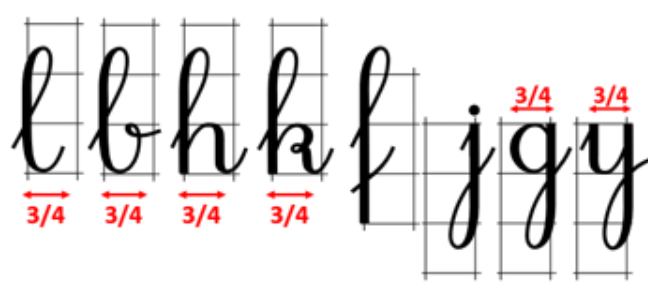
Achieving elegant and beautiful handwriting in English is an art that anyone can master with practice and dedication. In this comprehensive guide, we’ll explore valuable tips and techniques to enhance your penmanship and transform your writing into a work of art.
1. Choose the Right Tools
Quality Pens and Pencils
Invest in high-quality pens and pencils with smooth ink flow. Gel pens and fine-tipped markers are often preferred for neat and precise writing.

Beautiful Handwriting with Pencil
Source: https://www.youtube.com/shorts/jw6ImMmfmP0
Selecting the Right Paper
Choose a paper that complements your writing instrument. Smooth, high-quality paper can enhance the overall writing experience and prevent ink from bleeding.
Experiment with Various Writing Instruments
Try different types of pens, pencils, and markers to find the one that suits your handwriting style the best. Some people prefer the precision of fine-tipped pens, while others may enjoy the smoothness of a rollerball.
Consider Fountain Pens
Fountain pens, with their smooth ink flow and variable line thickness, can add an elegant touch to your handwriting. Experiment with different nib sizes to find the one that works best for you.
Beautiful Handwriting with a Fountain Pen
Maintain Your Tools
Keep your pens and pencils in good condition by regularly cleaning them. Replace ink cartridges or refills as needed to ensure a consistent flow of ink.
Use Guideline Sheets
Practice on guideline sheets to maintain consistent letter height and spacing. This will help you develop a uniform and attractive handwriting style.
Ergonomic Grips
Pay attention to the grip of your writing instrument. Choose pens and pencils with ergonomic designs that are comfortable to hold for extended periods, promoting smoother and more controlled writing.
Experiment with Colors
While black and blue are standard colors, don’t hesitate to experiment with other colors. Colored inks can add flair to your handwriting, making it more visually appealing.
Try Calligraphy Pens
Consider incorporating calligraphy pens into your writing routine for an artistic touch. Practice different calligraphy styles to add variety to your handwritten content.
Remember, the key is to find tools that feel comfortable for you and complement your personal writing style. Experimentation and practice will help you discover the perfect combination for achieving beautiful handwriting in English.
2. Master Letterforms
Pay attention to the individual shapes of letters. Practice writing each letter of the alphabet slowly and deliberately. Focus on maintaining consistent size and spacing. Utilize handwriting worksheets to guide your practice.

Start with Studying Letter Anatomy:
Begin by studying the anatomy of each letter. Understand the fundamental strokes, lines, and curves that make up each letterform. This knowledge will serve as the foundation for mastering letter shapes.
Separate Letters into Groups of Similar Strokes
Separating letters into groups of similar strokes is a strategic approach to mastering letterforms in English handwriting. By identifying common stroke patterns shared among letters, such as vertical lines or curved strokes, this method allows for focused and systematic practice. Grouping letters based on shared characteristics enables a more nuanced understanding of their structure and facilitates targeted muscle memory development. Sequentially practicing letters within these stroke groups and gradually incorporating them into mixed exercises helps create a logical and progressive learning path. This approach not only refines individual letters but also enhances the transitions between them, contributing to overall fluidity and coherence in your beautiful handwriting.

3. Perfect Your Posture
Maintain good posture while writing to ensure a smooth and controlled hand movement. Sit up straight with both feet flat on the ground, and position your paper at a comfortable angle.
4. Find Your Style
Experiment with different handwriting styles to discover what suits you best. Whether you prefer cursive, print, or a combination of both, choose a style that feels natural and allows you to express your personality.
5. Patience & Focus on Consistency
Achieving beautiful handwriting in English is a gradual process that demands both patience and a steadfast commitment to consistency. Cultivating an elegant script takes time, and the key lies in dedicating regular, focused practice sessions. Patience is paramount, especially during the initial stages when you may be refining your technique and building muscle memory. Resist the urge to rush, and instead, concentrate on each stroke and letterform deliberately. Understand that progress is incremental, and improvements will become more evident with persistent effort.
Consistency is equally crucial in developing a refined handwriting style. Maintain uniformity in letter size, slant, and spacing throughout your writing. Consistent practice not only enhances the visual appeal of your script but also solidifies the muscle memory needed for effortless and graceful writing. Regularly revisit and reinforce your practice routines, emphasizing the same principles each time to embed good habits. By combining patience with a focused commitment to consistency, you’ll find that your efforts gradually transform into a beautifully crafted and enduring handwriting style.
6. Analyze and Improve
Analyzing and refining your handwriting is a vital step on the journey to achieving beautiful penmanship in English. Regular self-assessment plays a key role in identifying areas for improvement. Take the time to review your written work critically, examining the consistency of letter shapes, spacing, and overall presentation. Look for patterns in your writing that may need adjustment, and be receptive to recognizing both strengths and weaknesses.
Seeking feedback from experienced handwriting teachers can provide invaluable insights. These professionals possess a trained eye for recognizing nuances in letterforms and can offer constructive guidance tailored to your individual needs. Don’t hesitate to share samples of your writing with them and ask for specific feedback. Their expertise can pinpoint areas requiring attention and provide targeted exercises to address those challenges.
In addition to external feedback, consider keeping a handwriting journal where you track your progress, noting areas where you’ve seen improvement and areas that still require focus. Regularly revisit your goals, adjusting them as needed based on your evolving skills. Remember, the journey to beautiful handwriting is an ongoing process of analysis, adjustment, and improvement, and every effort you invest in refining your script brings you closer to achieving the elegant and polished style you desire.
A Beautiful Handwriting Teacher Giving Feedbacks For Her Student’s Handwriting
(Auto-Translate to English is available)
7. Embrace Creativity
Transforming your handwriting into a work of art involves not only precision but also a touch of creativity. Embracing creativity allows you to infuse your unique style and personality into your script, making it truly distinctive. Here are some ways to inject creativity into your handwriting:
Experiment with Styles:
Explore different writing styles, such as cursive, print, or a blend of both. Experimenting with various styles can help you discover the one that resonates with your aesthetic preferences.
Play with Lettering Size:
Vary the size of your letters for emphasis and visual interest. Experiment with larger headlines and smaller subtext to create a dynamic and captivating script.
Incorporate Flourishes:
Add decorative flourishes to certain letters or the ends of words to give your handwriting an artistic flair. However, be mindful of balance to ensure that the flourishes enhance rather than overwhelm.
Use Colored Inks:
Introduce a spectrum of colors to your writing by using colored inks. Experiment with different hues to make certain words or phrases stand out, adding vibrancy and personality to your script.
Personalize Your Signature:
Develop a unique and stylized signature that reflects your personality. Your signature is an opportunity to showcase your individuality, so feel free to get creative with it.
Combine Fonts:
Mix and match different fonts within a single piece of writing. Combining fonts can create visual interest and convey different tones for various parts of your text.
Doodle and Sketch:
Integrate small doodles or sketches into your writing to add a touch of creativity. These can be simple drawings or patterns that complement the content.
Create Decorative Headings:
Design decorative headings for titles or section headers. Experiment with different lettering styles and embellishments to make these elements visually appealing.
Add Calligraphy Elements:
Incorporate basic calligraphy elements, such as thicker downstrokes and thinner upstrokes, to create a more dynamic and elegant script.
Remember that embracing creativity is about expressing yourself through your writing. Allow your personality to shine through, and don’t be afraid to try new things. Whether it’s through unique lettering styles, colors, or artistic embellishments, infusing creativity into your handwriting makes the process enjoyable and results in a script that is both beautiful and uniquely yours.
Conclusion
Transforming your handwriting into a thing of beauty is an achievable goal with dedication and the right approach. By following these tips and consistently practicing, you’ll witness a remarkable improvement in your penmanship. Embrace the joy of writing beautifully in English, and let your unique style shine through.
For more tips on honing your handwriting skills and other language-related insights, explore our blog. Happy writing!